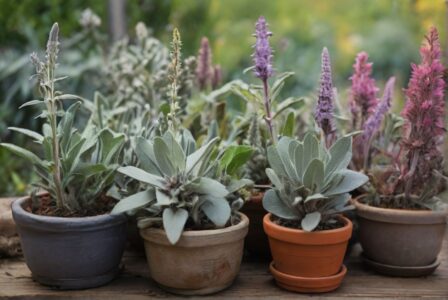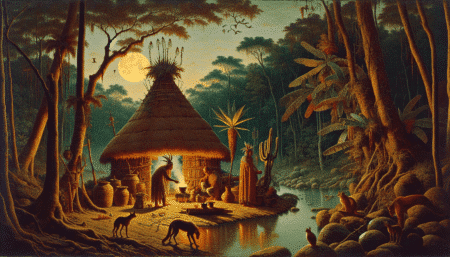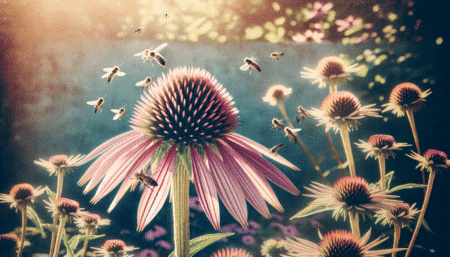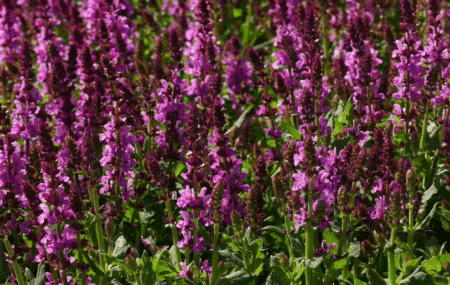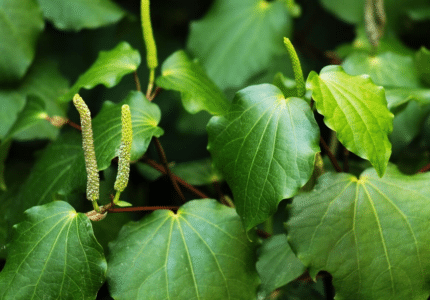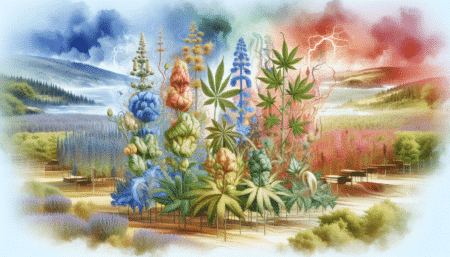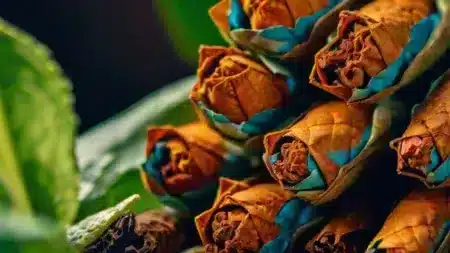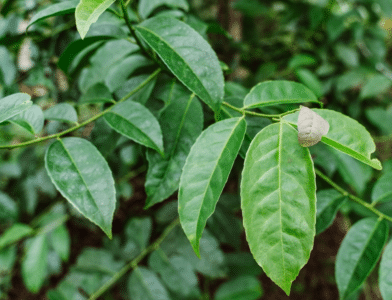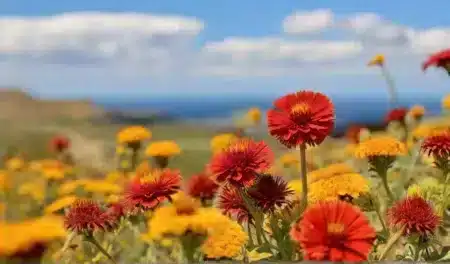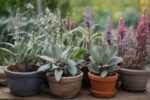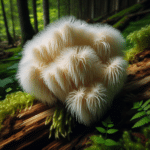- Introduction to a few of the most important Native American plants
- Echinacea (Echinacea)
- California golden poppy (Eschscholzia californica)
- White sage (Salvia apiana)
- Golden balm, Indian nettle (Monarda didyma)
- The role of plants in aboriginal spirituality and medicine
- Conclusion and outlook
1. introduction to a few of the most important Native American plants
Many North American plants have found their way into European gardens due to similar temperate climatic conditions and a richer flora than in Europe[1]. However, industrialized agriculture and modern land use practices have caused many of these native North American plants to decline, especially in the Prairie region[1]. This underlines the importance of the traditional knowledge of the indigenous people, who had a deep connection to nature and used resources, especially plants, in a sustainable and respectful way[1]. By taking this knowledge into account, not only can the conservation of these important plant species be promoted, but the rich cultural traditions of the North American Indians, their ancestors and various Indian tribes in North America, including the Apache and other indigenous peoples, can also be honored[1][2].
In this article, we delve into the world of some of the most important Native American plants and explore their role not only in spirituality and medicine, but also in the history and culture of these advanced civilizations. From coneflower (Echinacea) to white sage (Salvia apiana) and golden balm (Monarda didyma), we will shed light on how these plants were used and their significance today. We will also show how this traditional knowledge and conservation efforts are kept alive in reservations and through the transmission of Native American history[1][2].
2. coneflower (Echinacea)
Echinacea is not only a popular plant because of its eye-catching flowers, but also because of its many medicinal uses. Native Americans used echinacea to treat a wide range of ailments such as wounds, burns, mumps, toothache, colds, stomach cramps, headaches and snake bites[3]. The plant activates the immune system and is therefore often used to prevent and treat colds[3].
- Medicinal use of coneflower species:
- Narrow-leaved coneflower (Echinacea angustifolia): Traditionally used to strengthen the immune system and treat respiratory infections[3].
- Pale coneflower (Echinacea pallida): Often used for its anti-inflammatory properties on skin wounds[3].
- Purple coneflower (Echinacea purpurea): Most widely used in modern Herbal medicineespecially for the supportive treatment of frequently recurring respiratory and urinary tract infections and externally for poorly healing wounds[3].
The plant thrives best in full sun and well-drained soil, with a recommended distance of 30 to 70 cm between plants, depending on the variety[4]. The roots, leaves and flowers of echinacea are used to make plant juices, extracts and teas[5]. Echinacea contains anti-inflammatory substances that help fight bacteria and strengthen the immune system[5]. The plant is popular worldwide and is available in various colors, including white, pink and red, and attracts bumblebees and other hymenoptera in particular[5].
3. the California golden poppy (Eschscholzia californica)
The California golden poppy, also known as Eschscholzia californica, is a plant species originally from California and other southwestern US states[8]. This plant has a profound cultural significance for the Native Americans, who used it for both medicinal and spiritual purposes[8]. The leaves were used as an aid to sleep and relaxation, as a mild painkiller and to treat lice[8]. It is particularly interesting that the women of the Cahuilla tribe used the pollen as a cosmetic[8].
- Medical and cosmetic applications:
The plant contains alkaloids such as allocryptopine, californidine, protopine and chelerythrine, which have pharmaceutical applications[8]. In traditional medicine and homeopathy, the California golden poppy is used to relieve mental stress and as a sleep aid[8]. As the Californian state flower, the California golden poppy is protected and is also known as the Ornamental plant and for pharmaceutical purposes used in France[8].
- Pharmaceutical applications and protection status:
The California golden poppy is a robust plant that withstands dry conditions and poor soil well[8]. It is a popular choice for rock gardens and as a bee pasture, which underlines its versatility and ecological importance[8].
4. white sage (Salvia apiana)
White sage (Salvia apiana) is a robust species of sage native to California with a strong, resinous fragrance that is ideal for incense and culinary purposes is suitable[10]. Originally from southern California and Baja California, this perennial prefers well-drained, sandy or loamy soils and thrives best in full sun[10]. The flowering period in June attracts bees and other insects, while the plant can reach a height of up to 50 cm[10].
- Intended use:
- Smudging: White sage is mainly used for incense burning, a spiritual cleansing practice that consists of burning the plant to release its smoke and cleanse a person or space of negative energy[12].
- Culinary: Native Californians used white sage for baking and seasoning[10]. The seeds as well as the leaves and young stems can be used raw or cooked[11].
- Medical: Known for its antibacterial and antifungal properties in the United States, white sage is also used for skin cleansing and disinfecting the skin[10][11].
The cultural significance of white sage is deeply rooted in the sacred ceremonies and healing rituals of various North American Indian tribes, particularly in sweat lodge rituals[10][12]. This plant is not only known for its spiritual and medicinal uses, but also as an attractive ornamental plant that requires a sunny position, poor, water-permeable soil and good drainage in the pot[11]. Despite its popularity and many uses, it is recommended that white sage is not used by pregnant or breastfeeding women due to its astringent properties[12].
5. golden balm, Indian nettle (Monarda didyma)
Golden balm, also known as Indian nettle or Monarda didyma, is a plant traditionally used by the Oswego Indians as a medicinal plant and in a popular Teamixed named Oswego tea was used[18]. This perennial, rhizomatous herb species is characterized by its striking, zygomorphic, five-petalled, red flowers, which bloom from June to September in terminal clusters with red bracts[16]. The plant reaches a height of 80 to 150 centimeters and prefers moist forests and shrubs along riverbanks as its natural habitat[16].
- Scientific name: Monarda didyma
- Type: Perennial, rhizomatous herb
- Height: 80 to 150 centimeters
- Blossoms: Zygomorphic, five-leaved, red, in terminal clusters with red bracts
- Flowering time: June to September
- Distribution: Originally from the eastern part of the United States, they are found in damp forests and shrubs along riverbanks[16].
Golden balm is not only valued as an ornamental plant in gardens and landscaping, but is also used in the kitchen. Its leaves can be eaten fresh or cooked to flavor desserts and make tea[16]. Golden balm also contains the active ingredient thymol, which has antiseptic and diaphoretic properties and is used to treat fever, coughs and colds[18]. The plant also attracts bees and other hymenoptera due to its flowers, which underlines its ecological importance[16].
- Uses:
This plant is an example of how traditional knowledge and modern applications can go hand in hand to preserve and promote the diversity and benefits of native plant species.
6 The role of plants in aboriginal spirituality and medicine
Plants play a central role in Native American spirituality and medicine. They are used not only for medicinal purposes, but also in spiritual practices to connect with nature and ancestors. Some plants, such as white sage, are known for their use in purification rituals known as smudging, where the plants are burned to cleanse spaces or people of negative energy[11][12]. This practice emphasizes the deep connection between the indigenous people and nature and their belief that plants are a bridge to the spiritual world.
The Kichwa Indians, for example, have been using guayusa in various forms - chewed, smoked or brewed as tea - for over 1,500 years. This plant not only has medicinal uses, such as treating stomach problems and headaches, but is also valued for its ability to promote dreams and lucid dreaming, which is seen as a way to get in touch with the ancestors[15]. This shows how plants are not only used for physical health, but also for mental and spiritual health.
Ayahuasca, a hallucinogenic drink native to the Amazon region, is used in religious and healing ceremonies by the indigenous peoples of the Amazon basin. It contains DMT and MAOIs, which make it orally active, and is used for spiritual healing, self-discovery and therapeutic purposes. Ayahuasca ceremonies take place in a safe and controlled environment where participants experience the effects of the brew under the guidance of a trained facilitator. This practice demonstrates how deeply rooted plants are in indigenous healing and spiritual practices[22][23].
7 Conclusion and outlook
By looking at the important Native American plants and their diverse uses in Medicinespirituality and culture, it has become clear how important these species were and still are for the survival and cultural heritage of these peoples. The study of plants such as EchinaceaWhite Sage and Golden Balm emphasizes the wisdom and profound understanding of nature that Native Americans had, which is a valuable resource for sustainability and health in today's society.
Ultimately, the traditions and uses of these plants demonstrate the fusion of past and present, where ancient knowledge lives on in modern practices. Promoting and preserving this knowledge not only provides opportunities to improve our relationship with nature and health care, but also reminds us of the importance of respecting and recognizing indigenous cultures. Therefore, it is critical that we continue to explore ways to incorporate Native American traditions and knowledge into the preservation of their sacred plants and their sustainable use.
More questions and answers about Native American plants
When dealing with plants that are used in medicine and Native American spirituality play a role, caution is advised. In particular, white sage (Salvia apiana), known for its use in cleansing rituals, should not be used by pregnant or breastfeeding women due to its astringent properties[12]. This information is important to ensure the safe use of traditional plants and to avoid undesirable side effects.
Another fascinating example of the effectiveness of plant extracts is the research on 'Cinnamomum zeylanicum' and 'Curcuma longa'. These two plants showed the strongest inhibitory effects on human colon cancer cells[30]. This underlines the potential of plant extracts in modern medicine and the importance that traditional knowledge of plants can have for the development of new therapies.
It is fascinating to see how traditional knowledge and modern science can go hand in hand to further the understanding and use of plants. The findings on the astringent properties of certain plants and their potential role in cancer research are just two examples of how important and diverse the applications of plants can be.
Further links and book recommendations
- https://www.maria-laach.de/klosterbetriebe/klostergaertnerei/service/indianische-heilpflanzen.html
- https://www.avogel.ch/de/ihre-gesundheit/gesundheitsthemen/indianermedizin.php
- Paturi Felix - Indian medicinal plants (book)
- https://www.hachettebookgroup.com/articles/8-native-plants-native-medicine/
- Native American Medicinal Plants: An Ethnobotanical Dictionary
Youtube
References
[1] – https://hamburg.leibniz-lib.de/ausstellungen/museum-zoologie/indianer-verlorene-welten/pflanzenwelt-ureinwohner.html
[2] – https://leopard.tu-braunschweig.de/servlets/MCRFileNodeServlet/dbbs_derivate_00028087/Pflanzen_aus_Amerika-Ausstellung_Osnabrueck.pdf
[3] – https://www.schoenenberger.com/magazin/heilpflanzen/sonnenhut-echinacea/
[4] – https://www.baldur-garten.de/onion/content/pflege-tipps/gartenstauden/echinacea
[5] – https://vitagate.ch/de/gesund_und_schoen/naturheilkunde/heilpflanzen/echinacea_immunsystem
[6] – https://amira-welt.de/magazine/273/arzneipflanzenkunde-der-purpur-sonnenhut-echinacea-purpurea
[7] – https://www.avogel.ch/de/ihre-gesundheit/gesundheitsthemen/indianermedizin.php
[8] – https://de.wikipedia.org/wiki/Kalifornischer_Mohn
[9] – https://www.phoenix-der-lebenskraft.at/kalifornischer-mohn-eschscholzia-californica-tinktur
[10] – https://www.bio-kraeuter.de/BIO-Pflanzen/BIO-Kraeuter-Pflanzen/BIO-Kraeuter-S-wie-Salbei-und-Sonnenhut/H4-Weisser-Salbei-Indianischer-Raeuchersalbei-BIO::140.html
[11] – https://www.pflanzen-lexikon.com/Box/Salvia_apiana.html
[12] – https://www.hexenladen-hamburg.de/kraeuter-almanach/weisser-salbei-salvia-apiana/
[13] – https://spirit-raeucherwerk.de/k161/FAQ-Wei%C3%9Fer-Salbei-r%C3%A4uchern-%7C-Anleitung
[14] – https://www.grin.com/document/80103?lang=en
[15] – https://www.drinkguya.com/blogs/traditionelle-nutzung-von-guayusa/der-gebrauch-von-guayusa-tee-durch-die-ureinwohner
[16] – https://de.wikipedia.org/wiki/Indianernessel
[17] – https://www.kraeuter-und-duftpflanzen.de/heilkraeuter/monarda-goldmelisse
[18] – https://www.weltpflanzen.at/gewuerzkraeuter/goldmelisse-pflanze/
[19] – https://www.allgaeustauden.de/Kraeuter/Kraeuter-von-A-Z/M-Sonstige-Kraeuter/Monarda-didyma-Squaw-Indianernessel-Goldmelisse::10505.html
[20] – https://www.kraeuter-buch.de/kraeuter/Goldmelisse.html
[21] – https://www.baumschule-horstmann.de/shop/exec/product/1417/43064/Goldmelisse-Indianernessel-Monarde.html
[22] – https://de.wikipedia.org/wiki/Ayahuasca
[23] – https://www.drinkguya.com/blogs/traditionelle-nutzung-von-guayusa/ayahuasca-zeremonie-retreat-wirkung-dmt-rezept
[24] – https://wiki.yoga-vidya.de/Schamanismus
[25] – https://www.etsy.com/at/listing/1684412099/handcrafted-shamanic-drum-sacred-native
[26] – https://www.dw.com/de/indigenes-wissen-als-vorbild-f%C3%BCr-us-farmer/a-57954007
[27] – https://www.drinkguya.com/blogs/traditionelle-nutzung-von-guayusa/leben-traditionen-der-kichwa-indianer-und-quechua-volker
[28] – https://de.wikipedia.org/wiki/Indianer
[29] – https://www.planet-wissen.de/kultur/voelker/indigene_voelker_nordamerikas/pwieindigeneheute100.html
[30] – https://phytotherapie-seminare.ch/2011/06/17/goldmelisse-zitronenmelisse/


